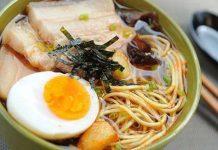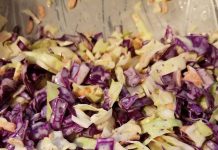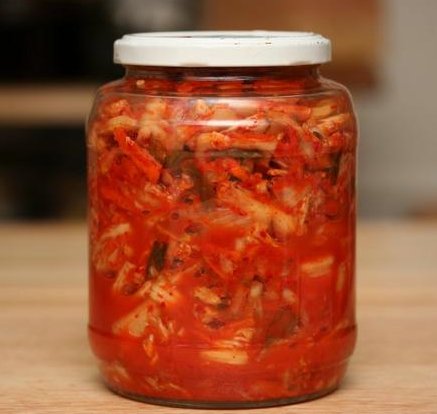INGREDIENTS
- 1 head (1.5 to 2 pounds) napa cabbage or green cabbage, cut into 2 by 1-inch pieces (reserve 2-3 large leaves, uncut). Note: You can also substitute bok choy in place of cabbage.
- 2 tablespoons kosher salt
- 2-3 large cloves garlic, minced
- 1 teaspoon fresh ginger, peeled and finely grated
- 1 teaspoon sugar (alternatively, use 1 apple or pear, thinly sliced)
- 3 tablespoons Korean chile pepper flakes or paste (gochugaru). Note: If you don’t live near a Korean market and can’t find this at your regular grocery store, substitute Aleppo pepper or 1 tablespoon of Sriracha, in a pinch. (Do not substitute red pepper flakes; they are much spicier than gochugaru.)
- 4 green onions, green parts only, cut into 2-inch pieces (optional)
- 1 medium yellow onion, thinly sliced (about ¼ cup) (optional)
- Optional: a few large carrots, thinly sliced
- For extra hotness: add 1 chili pepper (doesn’t need to be gochugaru)
EQUIPMENT
- A few quart-size, sterilized mason jars
- 1 large bowl
- Knife + cutting board
- 1 wooden spoon
- Food processor, blender, or mortar and pestle
- Yield: several quart-size jars (the exact number depends on how tightly the jars are
- packed, how finely the veggies are sliced, etc., so it’s best to have several jars on hand in
- case the recipe yields more than anticipated)
INSTRUCTIONS
- Wash all vegetables and pre-measure all of your ingredients so you have them ready to go. Set aside a few large cabbage leaves (to be used at the end of the process).
- Place the rest of the cabbage in the large bowl and sprinkle with 2 tablespoons of kosher salt. Toss to combine. Cover the large bowl and allow its contents to sit at room temperature until the cabbage has wilted (expect this to take a minimum of one hour and as many as 12). As it wilts, the cabbage will release around a ¼ cup of liquid.
- While the cabbage is wilting, combine the garlic, ginger, chili pepper, carrots (if you’re using them), and sugar (or the apple or pear, if using) in the food processor, blender, or mortar and pestle.
- Process the mixture until it forms a rough paste (around 30 seconds if using a food processor or blender; longer (as needed) if using a mortar and pestle). Be sure to scrape the container’s sides as needed.
- Now it’s time to check on the cabbage — it should be wilted, and there should be liquid in the bottom of the bowl. Remember this could take as many as 12 hours, so give it time if it needs it!
- Once the cabbage has wilted, drain it, set the liquid aside, and pat the leaves dry.
- Thoroughly mix the cabbage with the paste. This is your basic kimchi mixture.
- Pack the kimchi into the mason jars (try to avoid air pockets). Add equal amounts of the liquid to each jar, making sure that each jar has at least an inch of headspace (If needed, add some water to the jars to make sure the kimchi is completely covered by liquid.). Press the mixture down firmly using the wooden spoon, so that the brine covers the top.
- Cover the top of each jar with one of the reserved large cabbage leaves.
- Seal the jars loosely. Let them sit at room temperature (65 to 75 degrees Fahrenheit) for three to five days. Taste the kimchi every few days; it will be ready when it has developed a sour, spicy taste and a texture resembling that of sauerkraut.
- When the kimchi is ready, remove the big cabbage leaves from the top of each jar and store the jars (tightly sealed) in the fridge. The kimchi should keep for several months.
Credits to: fitcookingrecipes.com
















